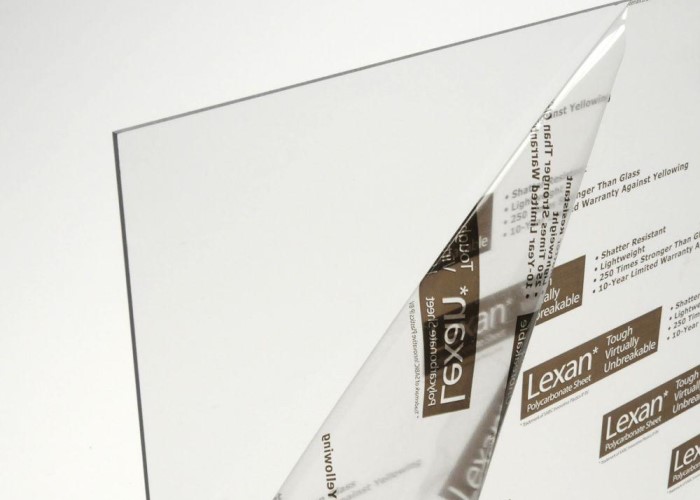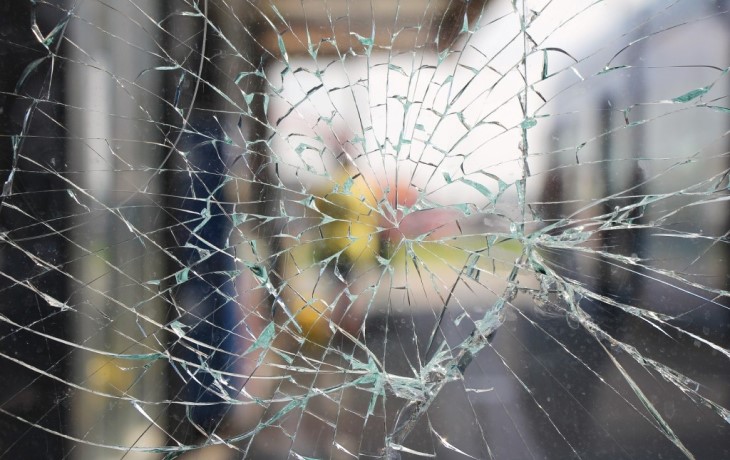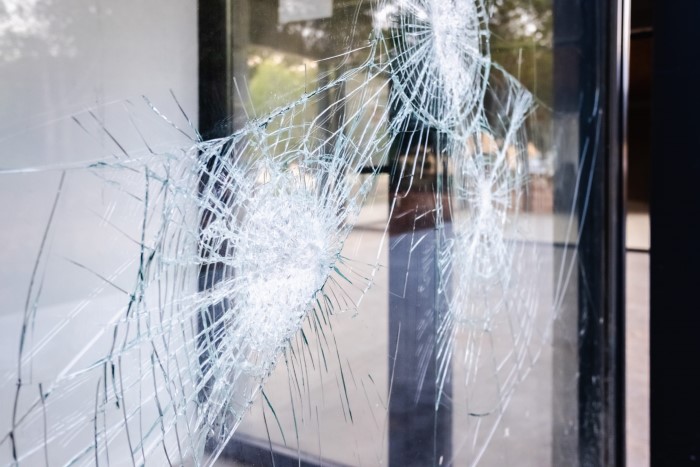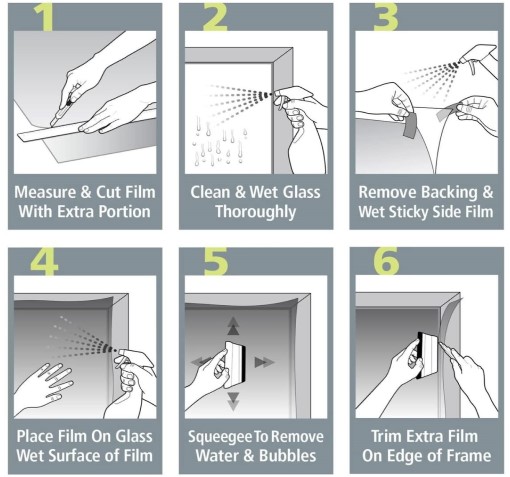Think of security film as an extra skin added to glass that makes it harder to shatter. Films can make it slightly harder for the glass to break to begin with, but the real value comes from how the film holds those broken shards together during/after a break — instead of all the fragments falling apart, the film acts like the bread on a sandwich holding the internal pieces together.
That slows down or discourages intruders because instead of one whack to the glass and viola, there’s an opening, they have to chip away at it until they can make a hole big enough. That extra time and activity makes it more likely you or a neighbor will notice what’s going on, too.
Besides intruders, you may also want to protect against broken glass and debris from storms. A common danger when sheltering during strong winds, for example, is broken glass shards zooming around like shrapnel. Film will help hold those broken pieces in place and prevent water or debris from working its way inside, such as a tornado-driven scrap of wood flying like an arrow.
This short video from 3M really hits it home:
If you have older glass and/or want to go above and beyond the basic 80-20 protection of film, consider upgrading the glass itself to hardened “tempered” glass or stronger plastics like plexiglass and polycarbonate. With or without film, these stronger materials are inherently harder to break — that’s why modern eyeglasses are made with plastics instead of actual glass.
Those stronger materials are particularly good for commercial buildings and windows around barns, basements, garages, etc.
Summary:
- None of these solutions are bulletproof. A strong storm or motivated intruder can still get in. The key is to make it much harder.
- Film is the go-to choice for most people because it’s cheap, pretty simple to do on your own, and doesn’t involve changing anything else about the window/door.
- If your glass is old or particularly vulnerable, consider the extra cost of upgrading the glass to a stronger material like tempered glass or plastics like polycarbonate or plexiglass. Although harder to break, glass replacements can suffer from discoloration and be sensitive to scratches and cleaners.
- If you’re installing your own plexiglass or polycarbonate, you can buy sheets at a local hardware store. Just look for thicknesses of ⅛ to ¼ of an inch, which is ideal for security windows.
- Film is great for renters because it doesn’t hurt your damage deposit and you’re not spending too much money on something you’ll leave behind when you move (film is removable but not reusable). Get permission first, but most landlords will be happy to have it.
- The DIY film route is pretty cheap and only requires some patience on your part as you align the adhesive film. A standard roll of DIY security film costs around $100 and covers about eight standard windows (roughly $12 per window).
- Or you can have a local installer do it for you. One of The Prepared’s team had a local company install 3M film on nine windows and a sliding glass door. Total cost was around $1,500 for a 2,000 square foot single-story home.
- Security films tend to be 4 to 12 mil thick. A mil is one-thousandth of an inch (0.001 inches), so an 8 mil window film is 0.008 inch thick.
- Films can be (near) invisible or more opaque to add privacy as well as security. Not all films labeled “privacy” or “security” actually help with hardening your glass, as some marketers use the word “security” in the sense that privacy = security.
- Some film reduces UV rays, keeping your home cooler and with less sun damage to furniture, flooring, etc.
Based on our experience and research, these are the top brands and products to guide your shopping.
DIY security film:
- Buy Decorative Film BDF S8MC. 8 mil security film. Blocks 99% of UV radiation. Highly-reviewed on all major ecommerce platforms.
- VViViD Clear Safety Window Film. 12 mil security film, and a great option for people who have extra large windows.
Professionally-installed film:
- 3M is really the go-to brand in the professionally-installed market. They offer very thick, 14 mil window film designed for seismic events, bomb blasts, and UV protection.
- Use this link to find a certified 3M installer in your area. Installation costs may vary depending on the installer.

These plexiglass brands all make products of about the same high quality:
Similar to plexiglass, these polycarbonate brands are also equally reliable:
Tempered and laminated glass:
- A bunch of trustworthy companies make tempered or laminated glass windows. Talk to a local expert if that’s something you’re interested in, and they can recommend the best brand for your area and climate.win
- Google “tempered or laminated window glass (your location)” to find an installer.
Be prepared. Don’t be a victim.
Want more great content and giveaways? Sign up for The Prepared’s free newsletter and get the best prepping content straight to your inbox. 1-2 emails a month, 0% spam.
Laminated vs. tempered glass, polycarbonate, and plexiglass
Laminated glass is made up of two pieces of glass with a polyvinyl plastic material in between. Laminated glass can be broken, but it will not shatter. Laminated glass is commonly found in skylights, glass tables, and the small panes found in doors. It usually costs $10 to $20 a square foot. For comparison, double-glazed glass, commonly found in double pane windows costs $3 to $6 a square foot. It’s not cheap, and you will need a professional if you want to incorporate it into your home.
Tempered glass is a heat-treated glass typically found on shower doors. The heat treatment makes tempered glass five times stronger than plain glass. When it breaks, tempered glass shatters into small pieces instead of the larger pieces — that’s seen as an advantage since larger pieces cut more deeply and cause serious injury. In fact, for this safety reason, tempered glass is actually required by some building codes in high-traffic areas.
That said, tempered glass can still be broken without a problem. Generally speaking, laminated glass is better than tempered, though normal glass with window film is still a better solution for most people.
Like laminated glass, tempered glass needs to be installed by a professional. Unlike the polycarbonate and plexiglass options described below, tempered glass cannot be easily cut, and must come from the factory in a pre-ordered size.
Polycarbonate is a plastic material that is almost unbreakable. Good polycarbonate is 300 times more impact resistant than plain glass — and it’s also much lighter. It’s also 20 to 30 times stronger than acrylic glass like plexiglass. That strength comes at a cost. Polycarbonate tends to cost four times the price of traditional glass.
Commercial buildings often use polycarbonate for their windows. Unfortunately, polycarbonate has some drawbacks: discoloration, scratches, and damage from common cleaning products.
If you need to replace a single pane window in a shed or an outlying building, polycarbonate is a viable alternative to traditional glass since it is nearly impossible to break. Polycarbonate can be easily cut, so you shouldn’t have a hard time installing it yourself.
Plexiglass is an acrylic (plastic) material that is lighter and more impact resistant than regular old window glass. If it does break, plexiglass doesn’t shatter. Like polycarbonate, it’s typically used in commercial settings or on work buildings.
Plexiglass isn’t quite as expensive as polycarbonate. Most plexiglass made in the United States these days shouldn’t yellow in the sun. Like polycarbonate, though, plexiglass can be difficult to clean and scratches very easily, so it’s best used in sheds or work buildings. You can easily cut plexiglass with a saw, and polish out scratches with a fine grain sandpaper.
Note: Many people use window films on plexiglass and polycarbonate to keep them from scratching or yellowing. But plexiglass and polycarbonate windows release gasses which make normal film bubble up, so it’s important to use a special film that adheres to the pane.
How to install security film
Security film is one of those rare home hardening measures that doesn’t require a drill, a hammer, or screws. With attention and commitment to lining up the film, it’s possible to install security film on your own in a few hours.
The included instructions should be pretty easy. This video from Buy Decorative Film is a solid demonstration of the proper technique.
Our biggest tips:
- Take your time when cleaning the glass — any dust specks on the glass, smudges of paint around the rim, frayed weather seals, etc. will make the film bubbly and less appealing.
- Don’t try to pre-cut the film to be an exact fit. Cut it from the main roll with an extra inch or so around each dimension. You’ll trim off the extra once it’s on the glass.
- Use the edge of a credit card or something similar to eliminate air bubbles and wrinkles by starting in the middle and pushing your way to the edges with even pressure.
- One of the most common errors for DIY’ers is not using enough liquid during install. Put something on the floor so you don’t worry about liquid drips.


